As far as I am aware of, there is only one book in existence that analyzes lifting from a framework of biomechanics and classical physics: Mark Rippetoe’s Starting Strength. Though the book is focused on general strength techniques, the powerful powerlifting optimizations contained in this article were distilled from principles found in Rippetoe’s book. If you like to learn, grab a copy of Starting Strength.
In the first installment of this series on powerlifting technique, we established four scientific principles to help us determine the optimal form for any given lift. They were as follows:
- The lifter/barbell system balances directly over the middle of the foot
- The bar must travel in a vertical line to maximize efficiency
- We must minimize all the relevant moment arms
- The range of motion should be as short as possible
Today, in this piece on powerlifting squat technique, we’re going to analyze each of these variables and how best we can manipulate them to produce the biggest squat possible. If you’d rather watch than read, check out my video on powerlifting squat leverages.
Bar Position
At heavy enough weights any attempt to squat forward or backward of mid-foot is futile. This imbalance is going to create an unnecessary lever arm between the middle of the foot and the bar. Remember, we want to minimize lever arms NOT create new ones! Fortunately, the body doesn’t usually allow for imbalanced positions under a heavy load.
Because the bar must remain over mid-foot to be balanced, the way you carry the bar is going to have a big impact on your back angle and knee angle in the bottom of the squat. Take a look at the front squat, high bar back squat, and the low bar back squat respectively:
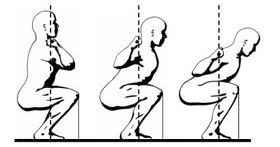
Rippetoe, Mark, and Lon Kilgore. Starting Strength: Basic Barbell Training. 2nd ed. Wichita Falls, TX: Aasgaard Co., 2007. Print.
Note where the bar is being carried in each movement. In the front squat, it is carried just behind the anterior deltoids. In the high bar squat, it is carried atop the traps. In the low bar squat, it is carried just above the rear deltoids.
The Front Squat
Let’s examine the front squat in more depth.
The Front Squat requires a very upright position because if you lean over too much the bar simply falls off your shoulders. Because the bar must also remain directly over mid-foot, this means that, in order to produce this upright position, the entire movement is going to consist mostly of forward knee travel. There is no other way to get the bar over mid-foot without it falling out of the rack position.
Before I go any further, can you use more weight on the front squat or the back squat? I’ve literally never seen anyone capable of front squatting more than they can back squat. The primary reason for this has to do with the manipulation of lever arms caused by the upright front squat back position.
As you can see, the front squat brings the hips very close to the bar. In some very flexible lifters, the hips are almost directly underneath the bar. The implication here is that the moment arm between the hips and the bar is almost eliminated entirely. However, the moment arm between the knees and the bar is lengthened in direct proportion to how much the moment arm between the hips and bar was shortened. So, basically all of the leverage that was on the hips, is shifted onto the knees.
The reason this causes you to lift less weight is very simple. When nearly all of leverage is between the knees and the bar, the quads must do nearly all of the work against gravity. The quads, while big, are but one muscle group. The hips, on the other hand, consist of the glutes, the adductors, and the hamstrings. Together the “posterior chain”, as it is popularly known, is simply a much larger, stronger group of muscles than the quadriceps.
High Bar Squats vs. Low Bar Squats
We want the posterior chain to do most of the work because it is more capable of doing so. In order for this to happen, we to need ensure that most of the relevant moment is between the hips and the bar rather than between the knee and the bar. Here we run into a “problem”.
With the typical high bar position used by many powerlifters, particularly bigger guys with inflexible shoulders, you must remain relatively upright or the bar will simply roll off your traps onto your neck. The high bar position certainly allows for more hip involvement than the front squat, but there is an even better option: the low bar squat (left, below):
Very frequently, lifters will criticize low bar squats as “good mornings” because squatters who employ this style often lean over quite a bit. While it is true that the more leaned over style of the low bar position is harder on the lower back than the more upright high bar position, calling it a “good morning” is completely inaccurate.
The good morning purposely uses an unnecessary lever arm between the bar and mid-foot to challenge the stabilization capacity of the spinal erectors. The large moment arm between the foot and the bar makes the erectors have to work overtime to keep you from falling over whilst simultaneously holding such a horizontal back position.
While a low bar squat may be bent over, it has little else in common with the good morning. The point of the low bar position is to allow you to carry the bar in such a way that it both: a) causes you to lean over more and b) allows you to do so without the bar slipping off of your back. In fact, if necessary, your back could be almost entirely parallel to the floor and the bar still wouldn’t move with a low bar rack position.
The reason why a low bar squat is superior to a high bar squat, for the purposes of powerlifting, is for the exact same reason that you can back squat more weight than you can front squat. The posterior chain is a bigger, stronger group of muscles than the quadriceps; the low bar squat uses more posterior chain and less quad than the high bar squat. Even though the low bar squat is harder on our lower back because it requires us to lean over more, the fact we get to use more posterior chain is a net win.
For the purposes of powerlifting, low bar is nearly always superior to high bar.
Minimizing Moment Arms
So, we’re left here with two important moment arms to discuss: a) the moment arm between the hips and the bar and b) the moment arm between the knees and the bar.
The primary determinant of the how long these moment arms are is the length of your thigh. The shorter your thighs, the less moment you’ll have to overcome when you squat. This is why guys with longer torsos relative to their legs have reputations as good squatters.
Taking a hacksaw to our bones isn’t a realistic option, but, luckily, there is something we can do anyways: stand wider. Yup, that’s it. All it takes to artificially shorten your thigh segment, for the purposes of the squat, is to take a wider stance and make sure you keep your knees pushed out.
Obviously standing wider doesn’t actually shorten your leg. All it does is put your legs at a more diagonal angle which shortens the horizontal distance between the hips and the knee. The leg length remains the same.
A wider stance is also going to allow you to be far more upright when you squat. The reason for this is very simple. If you’ve decreased the distance between your hips and the bar, you don’t have to lean over as far to get the bar over the middle of your foot. Not only does the wider stance manipulate the moment arms involved in the movement favorably, but it also mitigates the disadvantage of the low bar position. When you squat wide, you get the best of all worlds: an upright hip dominant squat with small moment arms.
Minimizing Range of Motion
If that wasn’t enough, standing wider also reduces the range of motion in the movement. The diagonal position of the legs in the starting position is going to reduce the vertical distance between the hips and the knees. Remember the squat’s rules; squat range of motion has to bring the crease of the hip below the knee. The further apart the hip and the knee are, the longer you have to travel. By standing wider, and bringing these two points closer together, we don’t have to move the bar as far.
Knee Travel in the Squat
So, even if you’re low bar squatting, how far forward should your knees go?
Some of you may have realized that you can actually completely eliminate the lever arm between the knees and the bar just by shoving your hips back even more and leaning even further forwards.
First let me be clear, this does not work at light weights. You still need to keep the center of mass (CoM) of the system over the middle of the foot. However, at heavy enough weights, the bar itself approximates the system’s CoM. At this point, putting your body behind behind the bar has a nearly negligible effect on the balancing the system (your body weight will always factor into CoM at least a little no matter how much weight you use). In the case of high bar vs. low bar, if less knee travel is better than more travel, why isn’t no knee travel even better?
Well, in fact, sometimes it is. For example, in geared powerlifting, where lifters wear specialized squat suits, minimizing any knee travel makes a great deal of sense. After all, the suit is helping hip extension. To take advantage of the suit, you’d want as much leverage as possible to be acting at the hips.
But what if you’re a raw squatter who is wearing knee wraps? Entirely eliminating the moment arm between the knees and the bar in this case will result in your not getting very much carryover from the wraps. Further still, what if you’re a raw squatter wearing nothing more than knee sleeves? In this case, you’re not getting equipment help at either of the relevant joints.
Here’s the thing. It isn’t possible to make a recommendation for knee travel except on a case by case basis. For people with long legs relative to their torso, zero knee travel will put their back nearly horizontal to the floor in the bottom of the squat. This just won’t work. It is too hard on the lower back. For others, having your knees go all the way out over your toes, even in a low bar position, will result in something that resembles a high bar, upright squat.
What you’re really looking for, as a raw lifter, is an amount of knee travel that will result in a back angle of approximately 50 to 60 degrees in the “hole” (at the bottom of the squat). Though I hate using this argument, this is the back angle most often observed when watching world recording holding squatters. From my experience squatting 551 at 220lbs, this is also what has worked best for me personally. At this time, I don’t have a recommendation for knee travel that is based on physics and biomechanics.
Anything more upright than a 50 to 60 degree back angle in the hole just isn’t necessary. If you’re more upright than that, you can afford to lean over more and shift some leverage onto the hips. Anything less than 50 to 60 degrees results in a squat that is very taxing on the lower back at heavy weights. This isn’t ideal because we want our prime movers to be the limiting factor. Prime movers are big muscles that are easily hypertrophied and trained. Stabilizers, generally speaking, are smaller and harder to improve upon. If you’re very bent over in the squat, you’ll usually benefit from a wider stance and more knee travel. Of course, for some folks, no matter what they do to manipulate the leverages, they’ll still be quite bent over because that’s just how they’re built. Nonetheless, you must do your best to optimize what you were given.
With that in mind, let me reiterate that the exact back angle and knee position that you’re looking for is completely dependent on your muscular strengths and individual anthropometry (limb lengths, muscle attachments, etc). However, more often than not, raw lifters can be observed to have a final knee position in the bottom of the squat that is within 1-2” of their toes in either direction (behind or in front).
Never in my life have I ever drawn so many stick figures. If you’re anything like me right now, you probably want some examples of the concepts we’ve discussed that actually use real human beings. If so, this video is exactly what you’re looking for:
How to Squat
Thus far, we’ve established WHY the optimal squatting technique for powerlifting includes a low bar position and a wider stance. Next, we’re going to discuss HOW to actually perform a powerlifting squat.
If you found this style of analysis to be refreshing, intriguing and valuable, Starting Strength is a must read for you. The book contains of 300 pages of detailed analysis on how to apply the principles of physics and biomechanics to the major compound lifts. This isn’t just about about some newbie’s program; the book is a veritable reference guide for how to analyze the lifts through a scientific lens.
In Part III, we’ll cover exactly how to get into the low bar position, how wide to stand, where to put your hands, and a variety of my favorite coaching cues that increase squat performance.
Like this Article? Subscribe to our Newsletter!
If you liked this articled, and you want instant updates whenever we put out new content, including exclusive subscriber articles and videos, sign up to our Newsletter!
Questions? Comments?
Table of Contents
Part I: The Scientific Principles of Powerlifting Technique
Part II: Squat Form Analysis
Part III: How to Squat Like A Powerlifter
Part IV: Bench Form Analysis
Part V: How to Bench Press Like A Powerlifter
Part VI: Deadlift Setup Science
Part VII: Deadlift Form Analysis
Part VIII: How to Deadlift Like a Powerlifter
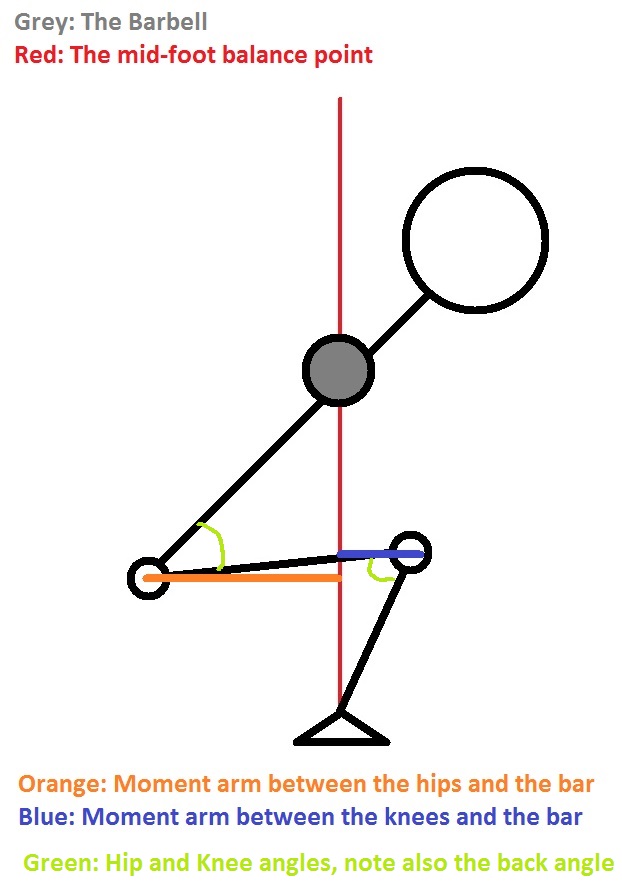
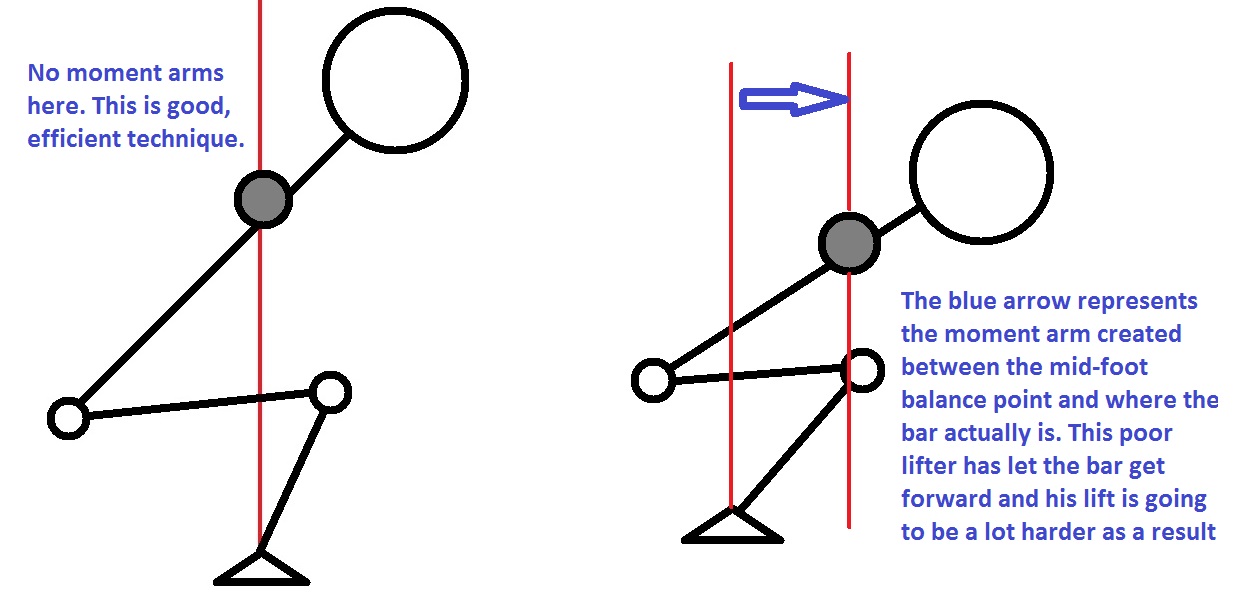

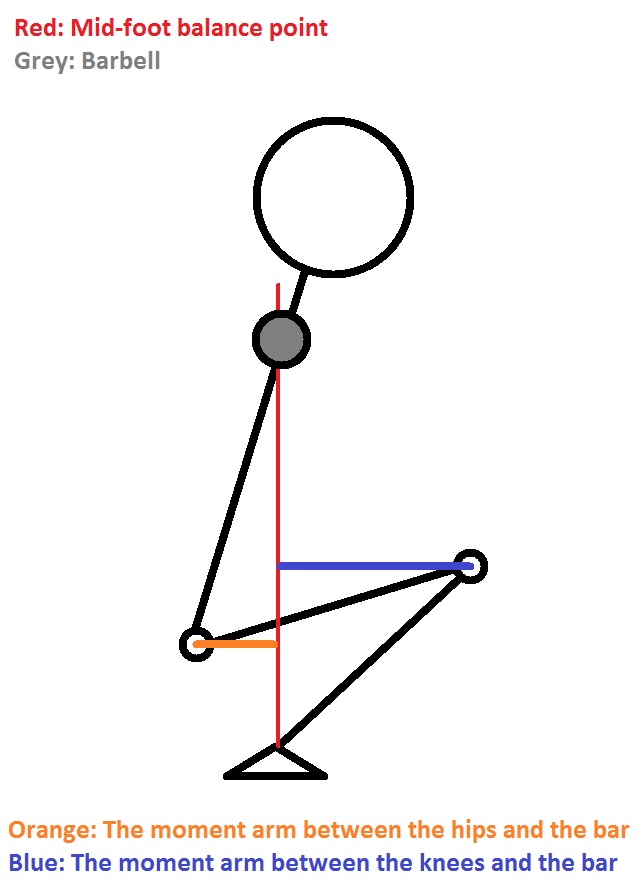
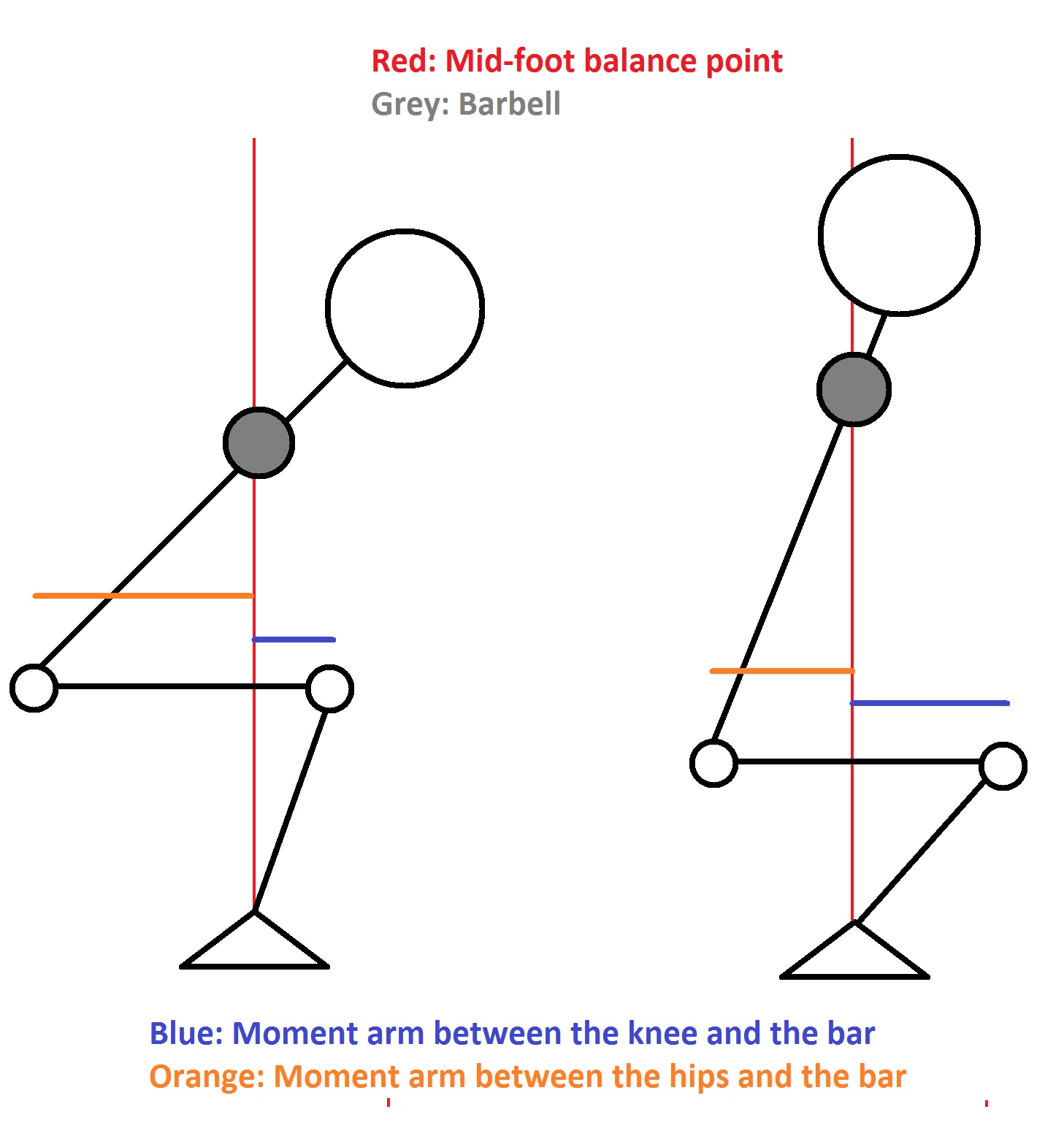

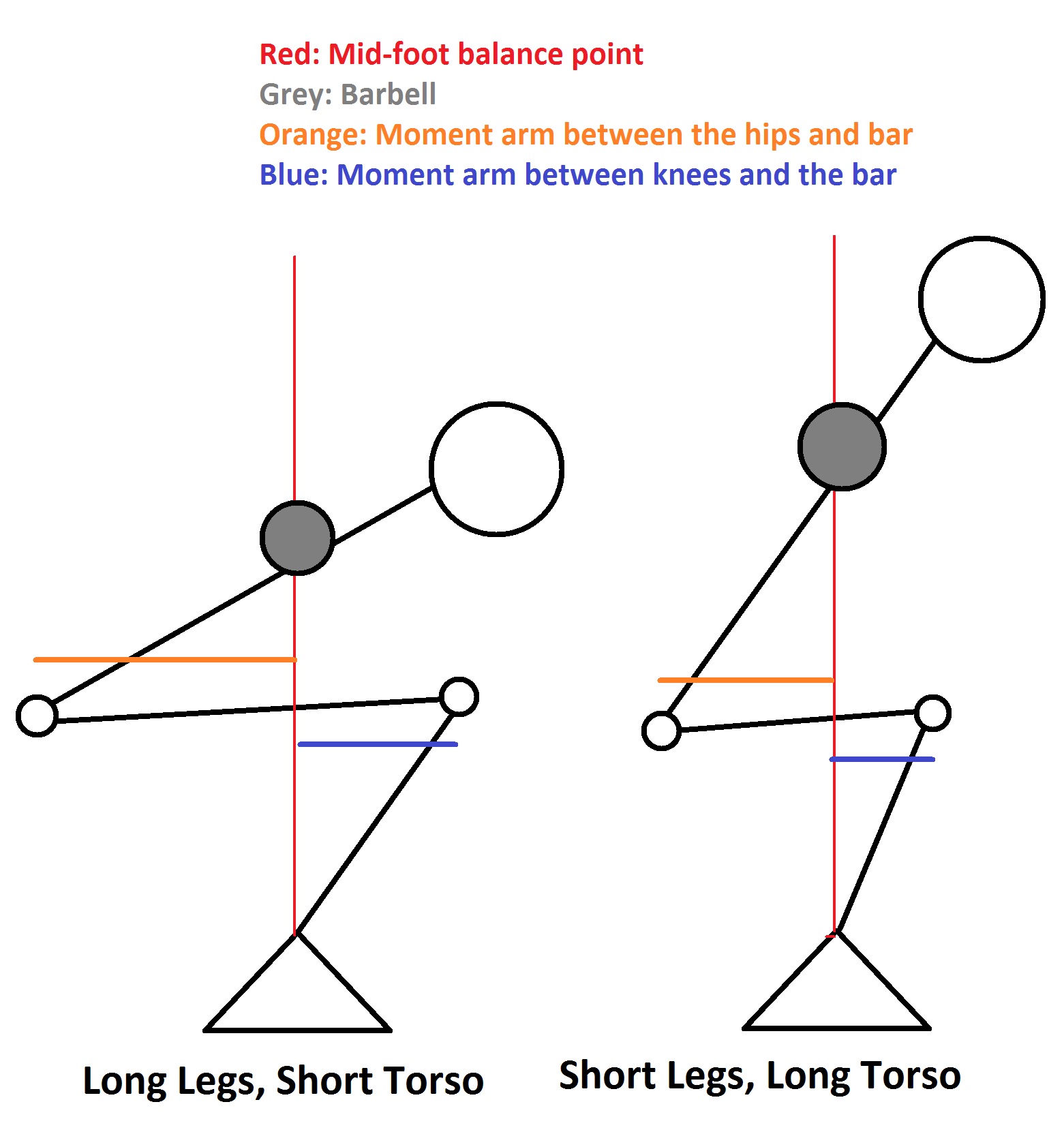
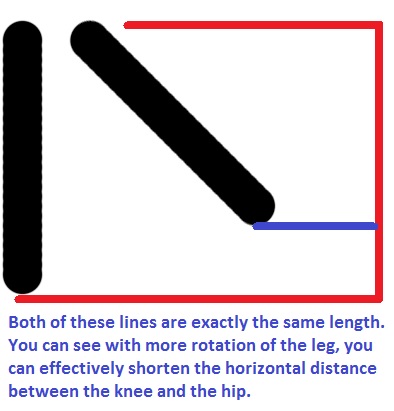

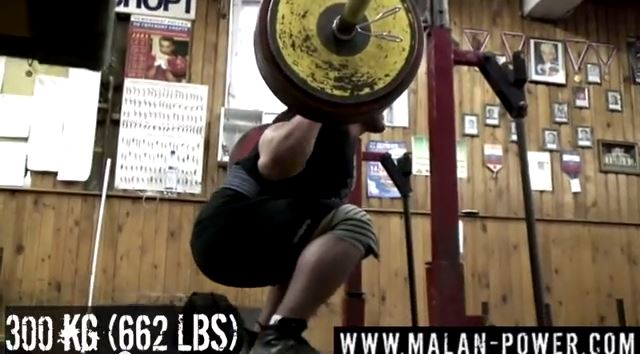
Thanks for the article. I have tried to squat wide before and it felt pretty weak. Part of this, I’m sure, is because the change of position that I wasn’t used to. However, I felt as if I lost a lot of hamstring stretch. Your 50-60 degree analasis is pretty compelling. I will be sure to pay closer attention to my back angle. Thanks again!
No problem! Thanks for reading.
You lose hamstring tension going into the hole in the high bar back squat and the front squat. This has to do with the fact that the more upright back angle necessitated by these positions also necessitates a “hips under” position that brings the distal and proximal attachments of the hamstring closer together. By standing wider, we haven’t brought these two points closer together literally, we’ve just decreased the horizontal distance as seen by the moment arms. If anything, a wide stance should have a MORE open knee angle than a medium stance because even less knee travel is required to maintain a favorable back angle. If the knees are coming forward, and the knee angle is closing more than in your medium stance squat, the stance is too wide; you’re probably relaxing to hit depth. I’ll cover this in much greater detail in the next piece, but “wide” doesn’t necessarily mean Westside wide. Wide depends on your anthropometry, flexibility, and federation depth requirements.
Hope that helps.
I think this is a great write up, but is an oversimplification when looking at the bar as the application of force point for all the lever arms instead of looking at each of the lever arms individually, as the forces and moment arms are truly being transmitted through their ends.
For example, I don’t believe that it’s the knees being posteriorly closer to the bar position that really helps with a wider stances. It’s not only the anterior/posterior direction that matters here when talking on physics. The force from the weight of the bar is being transmitted down the spine, transferred through the hips, and into the thigh at that end in the hips capsule. The downward force is focused on a point, not a plane, so what really matters from a loading perspective is the absolute horizontal distance (both posterior/anterior and left/right. So the hypotnuse of the triangle or direction the thigh bone lies in) from where the spine/loading goes through the pelvis and the knee joint. That’s the moment arm here, and it doesn’t change with a wider stance.
I think what is really happening to make the wider stance more advantageous is that at the bottom of the squat is that your knee and hip joints are more open, providing the advantage covered in the previous article. Here’s where that purely anterior/poterior moment arm does actually some into play. The wider stance allows a more upright torso since it moves the midfoot posteriorly closer to the hip, the moment arm you currently refer to. To keep the bar over the midfoot, this necesitates one of two adjustments. One can either use a slightly more vertical torso, putting less strain on the stratic strength of the back without shifting as much of the load into the knee joint as with a closed stance. not as much load is shifted there because that shift only affects the enterior/posterior direction of the thigh moment arm, not the left/right (i keep using this, don’t know the anatomical term).
The other adjustment that can be made is that instead of using a steeper back angle, one can keep the same one but move the bar even further down their back to get it back over the midfoot, This seems to be the choice many succesful extreme low bar squatters, like Dan Green, take.
Please tell me if I’m off the mark here. I’ve always been confused by the statement that the thigh lever arms are reduced by using the wider stance, when looked at through the perspective of the force of the load being transferred down the spine which make anterior/posterior vs left/right not matter. Is it a matter of the moment at the hip being reduced somehow?
Probably should have finished reading before I posted as you address a few things, but not all.
Fantastic comment. Thanks for writing in, man.
I think it is important to note that one of the goals of the low bar position, in general, regardless of the effect on the relevant moment arms, is to utilize more of the posterior chain than is utilized in the high bar squat. In actuality, the high bar squat increases the effective length of the torso so it actually decreases the total moment on the system. However, we know that even when high bar is taken to the same depth as low bar, the vast majority of lifters still tend to squat more with the low bar style. With high bar, the knee angle is more closed, yes, but the hip angle is commensurately more open. In fact, because of the length of the torso has been increased by the high bar position, relatively speaking, the sum of both angles in the bottom of a high bar squat, taken to the same depth as a low bar squat, is actually greater. What’s my point here? We’re definitely working with a complex system and the strength capacity of the different musculature must also be taken into account. Generally speaking, the posterior chain has a greater strength capacity than the anterior chain and it makes sense to shift more of the load to the posterior than the anterior as a result.
As far as your comment about the wider stance not actually changing the total moment force due to the fact that, whilst it decreases the anterior/posterior moment, it simultaneously increases the lateral/medial moment, well I have to think about this. Very interesting comment. We have to remember that moment is the force which tends to cause a rotation about an axis. The bar itself is the point of force application, but the force operating on the system is gravity which operates strictly in the vertical plane. I am not sure that increasing the lateral distance between the hip and the knee increases moment. But it does increase something. Let me think about this. Great point.